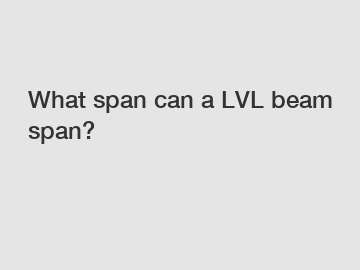When it comes to building structures, particularly in residential and commercial construction, one of the key components that often gets overlooked is the beam. Beams are critical in providing support and stability to a building, transferring the weight of the structure down to the foundation. Laminated veneer lumber (LVL) beams are one of the most popular options for builders due to their strength and durability. But just how much weight can an LVL beam span?
LVL beams are engineered wood products that are made by bonding multiple layers of thin wood veneers together with adhesive. This process creates a beam that is much stronger and more stable than traditional solid wood beams. LVL beams are known for their superior strength-to-weight ratio and can be used in a variety of applications, from floor joists to roof rafters.
The span of an LVL beam is determined by a number of factors, including the size of the beam, the type of load it will be supporting, and the allowable deflection (or bending) of the beam. LVL beams come in a variety of sizes, ranging from 1.75 inches thick to 3.5 inches thick, and can span anywhere from 6 feet to over 50 feet, depending on the size and load requirements.

For example, a 1.75-inch thick LVL beam with a load-bearing capacity of 2,500 pounds can span up to 12 feet, while a 3.5-inch thick LVL beam with a load-bearing capacity of 5,000 pounds can span up to 24 feet. It's important to note that these are just general guidelines and the actual span of an LVL beam will vary depending on the specific application and building codes in your area.
When determining the span of an LVL beam, it's crucial to work with a structural engineer or architect who can accurately calculate the load requirements and design a beam that meets the specific needs of your project. Factors such as the type of load (uniform or point load), the spacing of the beams, and the level of deflection that is acceptable must all be taken into consideration when designing a beam system.
In addition to the size and load requirements, the type of wood and grade of the LVL beam will also impact its span. LVL beams are available in a variety of wood species, including pine, fir, spruce, and cedar, with each offering different levels of strength and durability. Higher grade LVL beams are typically made from premium veneers and are more resistant to warping, twisting, and bowing, making them ideal for longer spans.
It's also important to consider the installation of the LVL beam when determining its span. Proper installation, including proper support and bracing, is essential to ensure the beam functions as intended and can safely support the weight of the structure. Working with a professional contractor who has experience in installing LVL beams will help ensure that the beam is installed correctly and meets all building code requirements.
In conclusion, the span of an LVL beam can vary depending on a number of factors, including the size of the beam, the type of load it will be supporting, and the grade of the wood. LVL beams are a versatile and durable option for builders looking for a strong and stable beam system. Whether you're building a residential home or a commercial structure, LVL beams can provide the support and stability you need to ensure your project is safe and secure. Working with a structural engineer or architect to design and install LVL beams will help ensure that your project meets all building code requirements and stands the test of time.
Contact us to discuss your requirements of 10 foot sheets of plywood, Application of 18mm Phenolic Plywood, hardboard plywood. Our experienced sales team can help you identify the options that best suit your needs.





Comments
All Comments ( 0 )